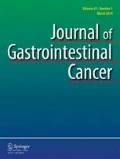Summary
The tumor markers CEA, CA 19-9, CA-50, CA-195, and TATI were analyzed in patient, with pancreatic disease, a, well a, disorder, in the upper quadrant of the abdomen. Two different method, for CA-50, namely CA-50 IRMA and CA-50 DELFIA, which are based on the same monoclonal antibody, were used. The sensitivities, specificities, and predictive value, of positive and negative result, were calculated at one, three, and ten multiple, of the upper reference value (“cutoff”) for each method. All the tumor marker, except TATI had sensitivites exceeding 90% at one cutoff level, but CEA had lowspecificity. Poorsensitivite, were observed for CEA and TATI at three cutoff levels, whereas CA 19-9, CA-50, and CA-195 hadsensitivitie, and specificities > 80%. ThesenSitivitie, of these tumor markers decreased at 10 cutoff levels, although the specificities exceeded 95%. The predictive value, of positive and negative result, were also evaluated at these three cutoff levels. High scores were observed at three cutoff levels. Examined together with the sensitivity and specificity, the evaluation at three cutoff level, indicated that 19–9, CA-50, and CA-195 can be used in the diagnostic arsenal for the detection of cancer of the exocrine pancrea, insymptomatic patients, and in the differential diagnosis between pancreatic cancer and chronic pancreatitis. Although CA-50 IRMA and CA-50 DELFIA are based on the same monoclonal antibody, there were substantial difference, in the level, of CA-50 in a lot of the patient, when samples were analyzed by the two methods. These difference, were shown to be methodological, and they affected the test evaluation, to some extent.
Similar content being viewed by others
References
Aoki K and Ogawa HJ. Cancer of the pancreas. International mortality trends. World Healthstat. Rep. 1978; 31: 2–27.
Levin DL, Connelly RR, and Devisa SS. Demographic characteristics of cancer of the pancreas, mortality, incidence, andsurvival. Cancer 1981; 47: 1456–1468.
Köhler G and Milstein C. Continuous cultures of fussed cells secreting antibody of predefined specificity. Nature 1975; 256: 495–497.
Gold P and Freedman SO. Specific carcinoembryonic antigen (CEA) in clinical medicine. Historical perspectives, pitfalls and projections. Cancer 1968; 42: 1399–1405.
Koprowski H, Steplewski Z, Mitchell KF, Herlyn M, Herlyn D, and Fulner P. Colorectal carcinoma antigens detected by hybridoma antibodies. Somat. Cell Genet. 1979; 5: 957–972.
Bucher Liv I, McClure M, Rake B, Space S, Westrick choemaker H, and Zurawski VR. Radioimmunometric assay for a monoclonal antibody defined tumor marker 19-9. Clin. Chem. 1983; 29: 549.
Lindholm L, Holmgren J, Svennerholm L, Fredman P, Nilsson O, Persson B, Myrvold H, and Lagergard T. Monoclonal antibodies against gastrointestinal tumour-associated antigen, isolated as monosialogangliosides. Int. Arch. Allergy Appl. Immunol. 1983; 71: 178–181.
Gupta MK, Arciaga R, Bukowski R, and Gaur P. CA-195: A new sensitive monoclonal antibody-defined tumor marker for pancreatic cancer. Test information from Hybritech Incorporated, San Diego, CA, 1988.
Huhtala ML, Pesonen K, Kalkkinen N, and Stenman UH. Purification and characterization of a tumor associated trypsin inhibitor (TATI) in urine of patient, with gynecological malignancy. J. Biol. Chem. 1982; 257: 13713–13716.
Hammarströms, Engvall E, Johansson BG, Svensson S, Sundblad G, and Goldstein IJ. Nature of the tumour-associated determinant(S) of carcinoembryonic antigen. Proc. Natl. Acad. Sci. USA 1975; 72: 1528–1532.
Magnani JL, Nilsson B, Brockhaus M, Zopf D, Steplewski Z, Koprowski H, and Ginsburg V. A monoclonal antibody-defined antigen with gastrointestinal cancer is a ganglioside containingsialylated lacto-N-fucopentaose II. J. Biol. Chem. 1982; 257: 14365–14369.
Månsson JE, Fredman P, Nilsson O, Lindholm L, Holmgren J, and Svennerholm L. Chemical structures of carcinoma ganglioside antigens defined by monoclonal antibody C-50 andsome allied ganglioside, of human pancreatic adenocarcinoma. Biochim. Biophys. Acta 1985; 834: 110–117.
Fukuta S, Magnani JL, Gaur P, and Ginsburg V. Monoclonal antibodyCC 195, which detects cancer-associated antigens inserum, binds to human Le-a blood group antigen and to its sialylated derivative. Arch. Biochem. Biophys. 1987; 255: 214–216.
Moore TL, Kupchick HZ, Marconi N, and Zamcheck N. Carcinoembryonic antigen assay in cancer of the colon, pancrea, and other digestive tract disorders. Am. J, Dig. Dis. 1971; 16: 1–7.
Jalanko H, Kuusela P, Roberts PJ, Sipponen P, Haglund C, and Mäkelä O. CompariSon of a new tumor marker CA 19-9 with alpha-fetoprotein and carcinoembryonic antigen in patient, with upper gastrointestinal diseases. J. Clin. Pathol.. 1984; 37: 218–222.
Holmgren J, Lindholm L, Persson B, Lagergård O, Nilsson O, Svennerholm L, Rudentam CM, Unsgaard B, Yngvason F, Petterssons, and Killander AF. Detection by monoclonal antibody of carbohydrate antigen CA-50 in serum of patient, with carcinoma. B. Med. J. 1984; 288: 1479–1482.
Bhargava AK, Petrelli NJ, Karna A, Parshall PL, Fitzpatrick JE, Douglass, HO, Herrera L, Bray K, and Gaur P. Serum levels of cancer-associated antigen CA-195 in gastrointestinal cancer, and it, comparison with CA 19-9. J. Clin. Lab. Anal. 1989; 3: 370–377.
Haglund C, Huhtala ML, Halila H, Nordling S, Roberts PJ, Scheinin TM, and Stenman UH. Tumour associated trypsin inhibitor, TATI, in patients with pancreatic cancer, pancreatiti, and benign biliary diseases. Br. J. Cancer 1986; 54: 297–303.
Haglund C. Tumour marker, in pancreatic cancer. PhD thesis, University of Helsinki, Finland, 1987.
Koprowski H, Brockhau, M, Blaszczyk M, Magnani J, Steplewski Z, and Ginsburg V. Lewis blood-type may affect the incidence of gastrointestinal cancer. Lancet. 1982; i: 1332–1333.
Masson P, Pålsson B, and Andrén-Sandberg A. Cancer associated tumour markers CA 19-9 and CA-50 in patients with pancreatic cancer with special reference to the Lewis blood cell status. Br. J. Cancer 1990; 62: 118–121.
Author information
Authors and Affiliations
Rights and permissions
About this article
Cite this article
Masson, P., Pålsson, B. & Andrén-Sandberg, Å. Evaluation of CEA, CA 19-9, CA-50, CA-195, and tati with special reference to pancreatic disorders. Int J Pancreatol 8, 333–344 (1991). https://doi.org/10.1007/BF02952725
Received:
Revised:
Accepted:
Issue Date:
DOI: https://doi.org/10.1007/BF02952725




